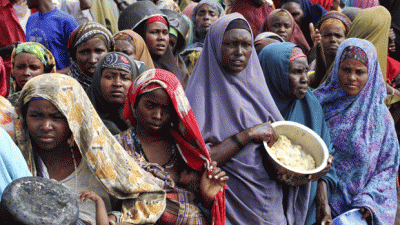UN labels famine crisis 'worst since WW2'

ROME-- Representatives from the FAO and WFP outlined the famine crisis gripping parts of Africa and Asia, which is considered 'one of the largest food crises in 70 years,' according to the press pack distributed at the Foreign Press Association. Denise Brown, Director of Emergencies at the WFP, described the situation as 'unprecedented' because of its sheer extent, and emphasised the need for increased support from the international community over the coming months to ensure food security for those at risk of famine.
At present globally there are about 108 million people in 48 countries who are experiencing hunger, a 35 percent increase from last year’s figure. In the four regions discussed, Northeastern Nigeria, South Sudan, Somalia and Yemen, the crises were provoked by conflict, with Somalia being further exacerbated by drought.
Arif Husain, the Chief Economist at the WFP explained the profound impact that conflicts can have on the infrastructure of countries with rural populations. The immense upheaval brought about by a nationwide conflict affects communities’ earning capability as they are unable to raise livestock and crop in the same way. In Somalia, this problem is made far worse by drought, with 2016 being the third consecutive year of drought, resulting in an average drop of 70 percent in citizens’ earnings.
In Northeastern Nigeria, the conflict is seriously affecting the commercial traffic in the region, leaving 5.1 million people food insecure, whereas in South Sudan this figure is an even higher 5.5 million, reflecting the impact of a prolonged conflict.
The country with the most food insecure, however, is Yemen, with 17 million people on the brink of crisis, and is also the only urban population of the four countries. The crisis in Yemen is result of a bitter civil war, with the two agricultural governorates in the country, Taiz and Al Hudaydah, being at the heart of the intense violence. The lack of locally produced food has had a knock-on affect across the country, meaning that not only is food scarce, but also many of those living and working in the city have not received their salaries since September.
While these four countries are the main focus for the UN agencies aiming to tackle the hunger crisis, the crushing impact the crises will have on neighbouring countries was also emphasised. The lack of food and resources in their home countries is forcing inhabitants to migrate across the continent, putting a serious strain on some of the world’s poorest countries. This leaves many African nations in a precarious situation, often on the brink of a food crisis if not already there.
The FAO and the WFP hope to work together to not only improve the current situation, but find long-term solutions for these countries in dire need. At the moment they have a funding gap of 218 million dollars, making it impossible to reach all those affected by the crises. They can only hope to stop the crises from boiling over, meanwhile searching for more permanent ways to reorganise the agricultural infrastructure of the conflict-ravaged countries.


